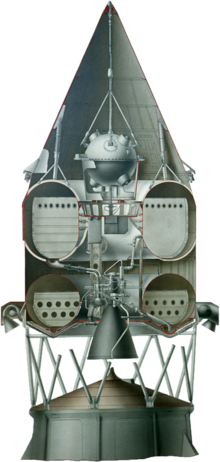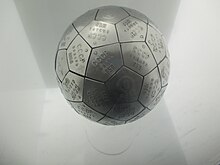Lunik 2
Coordinates: 29 ° 6 ′ 0 ″ N , 0 ° 0 ′ 0 ″ E
| Luna 2 | |||||||
|---|---|---|---|---|---|---|---|
| NSSDC ID | 1959-014A | ||||||
| Mission goal | Earth moon | ||||||
| Client |
|
||||||
| Launcher | Vostok (8K72) | ||||||
| construction | |||||||
| Takeoff mass | 390 kg | ||||||
| Course of the mission | |||||||
| Start date | September 12, 1959 | ||||||
| launch pad | Baikonur | ||||||
| End date | September 13, 1959 | ||||||
|
|||||||
Luna 2 ( Russian Луна-2 , Luna-2 ), also referred to as Lunik 2 in the western media , was the second space probe of the Soviet Union and the first lunar probe to hit the moon in a targeted manner.
construction
Lunik 2 was similar to its predecessor Lunik 1 , so it was a spherical body weighing 390 kg with a dominant antenna and an instrument part. The probe was equipped with a Geiger counter , a magnetometer , a micrometeorite detector and a scintillation counter , but did not have its own drive unit. Before the start, it was made sterile so as not to bring any microorganisms to the moon.
Flight history
The probe was launched on September 12, 1959 as part of the Lunik mission by an R-7 launcher. During the flight, a flash (sodium vapor) was ignited about 130,000 km away from the earth, which was visible to observatories on earth and, in addition to tracking the orbit , also served as an experiment on gas expansion in space.
After about 1.5 days, Lunik 2 reached the moon. The impact occurred on September 14 at 00:02:24 Moscow time (according to UTC on September 13). Shortly before the hard impact between the Autolycus and Archimedes craters - on the edge of the moon bay named Sinus Lunicus in her honor in 1970 - at a speed of 3.3 km / s (approx. 12,000 km / h), metal strips with Soviet Emblems emitted. The third rocket stage that followed the probe hit about 30 minutes later, also above the Swamp of Rot, Palus Putredinis , between the Archimedes and Autolycus craters, quite precisely on the prime meridian and about 29.1 degrees north latitude. Two objects resembling a soccer ball contained an explosive device, which released individual pentagonal stainless steel emblems.
Results
Lunik 2 confirmed the measurement of the Lunik 1 probe that flew past the moon, according to which the moon does not have a noticeably strong magnetic field or a comparably strong radiation belt compared to the earth .
Lunik 2 also had a special military-political significance in the context of the arms race in the Cold War . The probe's flight to the moon preceded Khrushchev's state visit to the USA only a few days and once again demonstrated the ability of the Soviet Union to attack with ICBMs at any time.
Soviet lunar research was continued with Lunik 3 soon after .
See also
literature
- E. Clark: Soviets Hit Moon, Data Flow Improves. In: Space Technology. 2, No. 4, October 1959, pp. 4-6
- William Roy Shelton: Soviet Space Exploration. The First Decade. Barker, London 1969, ISBN 0-213-17799-4
- Brian Harvey: The New Russian Space Program from Competition to Collaboration. Wiley, Chichester 1996, ISBN 0-471-96014-4
Web links
Individual evidence
- ↑ TASS: СООБЩЕНИЕ ТАСС. Pravda, September 14, 1959, accessed June 25, 2009 (Russian).
- ^ Image of the emblems on the Russian Wikipedia ( Memento from July 19, 2016 in the Internet Archive )


